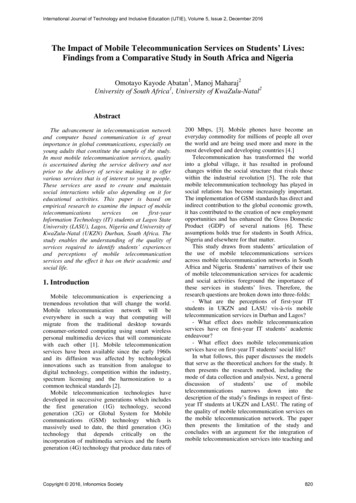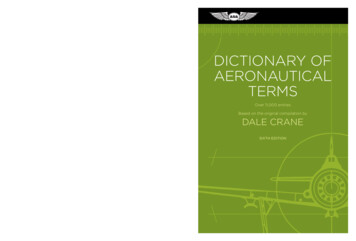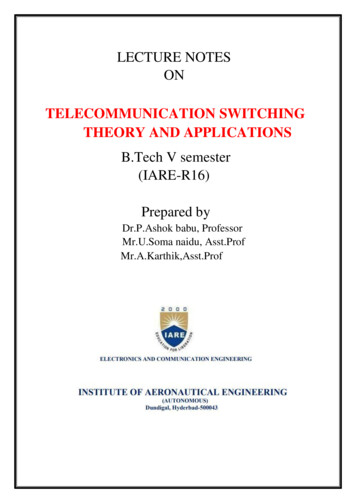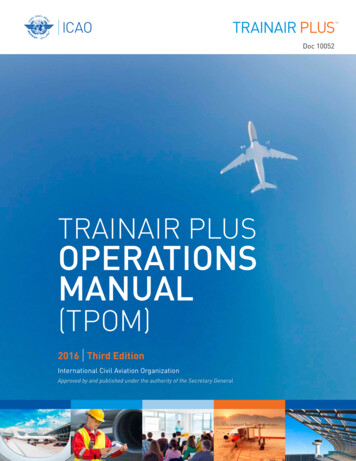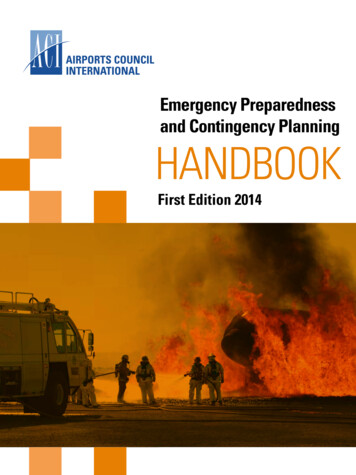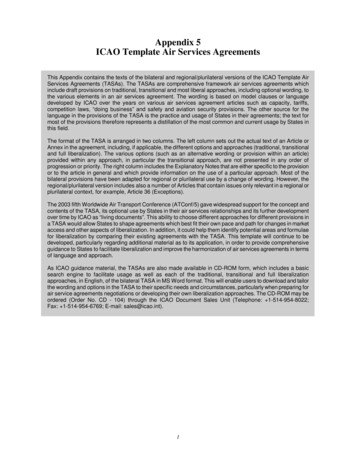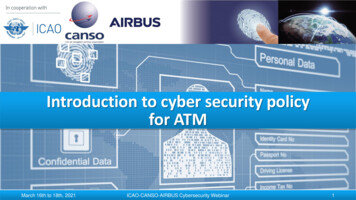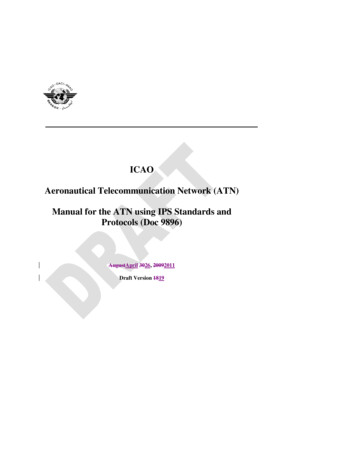
Transcription
ICAOAeronautical Telecommunication Network (ATN)Manual for the ATN using IPS Standards andProtocols (Doc 9896)AugustApril 3026, 20092011Draft Version 1819
DRAFT ICAO Manual for the ATN using IPS Standards and Protocols (Doc 9896)Draft Version 1819 AugustApril 3026, 201109FOREWORDThis document defines the data communications protocols and services to be used forimplementing the International Civil Aviation Organization (ICAO) AeronauticalTelecommunications Network (ATN) using the Internet Protocol Suite (IPS). Thematerial in this document is to be considered in conjunction with the relevant Standardsand Recommended Practices (SARPs) as contained in Annex 10, Volume III, and Part IChapter 3.Editorial practices in this document.The detailed technical specifications in this document that include the operative verb―shall‖ are essential to be implemented to secure proper operation of the ATN.The detailed technical specifications in this document that include the operative verb―should‖ are recommended for implementation in the ATN. However, particularimplementations may not require this specification to be implemented.The detailed technical specifications in this document that include the operative verb―may‖ are optional. The use or non use of optional items shall not preventinteroperability between ATN/IPS nodes.The Manual for the ATN using IPS Standards and Protocols is divided into the followingparts:Part I – Detailed Technical SpecificationsThis part contains a general description of ATN/IPS. It covers the network, transport andsecurity requirements for the ATN/IPS.Part II – Application SupportThis part contains a description of applications supported by the ATN/IPS. It includesconvergence mechanisms and application services that allow the operation of legacyATN/OSI applications over the ATN/IPS transport layer.Part III – GuidanceThis part contains guidance material on ATN/IPS communications including informationon architectures, and general information to support ATN/IPS implementation.i
ICAOAeronautical Telecommunication Network (ATN)Manual for the ATN using IPS Standards andProtocols (Doc 9896)Part IDetailed Technical Specifications
DRAFT ICAO Manual for the ATN using IPS Standards and Protocols (Doc 9896)Draft Version 1819 AugustApril 3026, 201109PART 1 TABLE OF CONTENTS1.0 INTRODUCTION. 21.1 GENERAL OVERVIEW .22.0 REQUIREMENTS. 42.1 ATN/IPS ADMINISTRATION .42.1.1 The ATN/IPS . 42.1.2 ATN/IPS Mobility . 42.2 LINK LAYER REQUIREMENTS .52.3 INTERNET LAYER REQUIREMENTS .52.3.1 General IPv6 Internetworking . 52.3.2 Mobile IPv6 . 52.3.3 Network Addressing . 52.3.4 Inter-Domain Routing . 62.3.5 Error Detection and Reporting . 72.3.6 Quality of Service (QoS) . 72.3.7 IP Version Transition . 72.4 TRANSPORT LAYER REQUIREMENTS.82.4.1 Transmission Control Protocol (TCP) . 82.4.2 User Datagram Protocol (UDP) . 82.5 SECURITY REQUIREMENTS .82.5.2 Ground-Ground Security . 82.5.2.1 Ground-Ground IPsec/IKEv2 . 82.5.3 Air-Ground Security. 92.5.3.1 Air-Ground Access Network Security . 92.5.3.2 Air-Ground IPsec/IKEv2 . 92.5.3.3 Air-Ground Transport Layer Security . 112.5.3.4 Air-Ground Application Layer Security. 112.6 PERFORMANCE .113.0 ATN APPLICATIONS . 123.1 GROUND APPLICATIONS .123.1.1 Telephony (VoIP) . 123.2 AIR-GROUND APPLICATIONS .123.2.1 Radio . 123.3 PERFORMANCE .123.3.1 Telephony (VoIP) . 123.3.2 Radio (VoIP) . 12APPENDIX A – AS NUMBERING PLAN . 131
DRAFT ICAO Manual for the ATN using IPS Standards and Protocols (Doc 9896)Draft Version 1819 AugustApril 3026, 2011091.0 INTRODUCTION1.1 GENERAL OVERVIEWThis manual contains the minimum communication protocols and services that willenable implementation of an ICAO Aeronautical Telecommunication Network (ATN)based on the Internet Protocol Suite (IPS), referred to as the ATN/IPS. The scope of thismanual is on interoperability across Administrative Domains in the ATN/IPSinternetwork, although the material in this manual may also be used within anAdministrative Domain. Implementation of the ATN/IPS, including the protocols andservices included in this manual, will take place on the basis of regional air navigationagreements between ICAO contracting States in accordance with Annex 10, Volume III,Part I, Chapter 3, and Paragraph 3.3.2. Regional planning and implementation groups(PIRG‘s) coordinate such agreements.The ATN/IPS protocol architecture is illustrated in Figure 1. The ATN/IPS has adoptedthe same four layer model as defined in Internet Society (ISOC) internet standardSTD003.Note. — STD003 is a combination of Internet Engineering Task Force (IETF) RFC 1122and RFC genceOSI/IPSConvergencePeer-to-Peer ConnectionsTransport Layer(TCP, UDP)Transport Layer(TCP, UDP)Inter-DomainRouterInter-DomainRouterInternet Layer(IPv6)Internet Layer(IPv6, BGP4 )Internet Layer(IPv6, BGP4 )Internet Layer(IPv6)Link LayerLink LayerLink LayerLink LayerLocal orIntra-DomainSubnetworkLocal re 1 – ATN/IPS Protocol Architecture2
DRAFT ICAO Manual for the ATN using IPS Standards and Protocols (Doc 9896)Draft Version 1819 AugustApril 3026, 201109This model has four abstraction layers called the link layer, the internet or IP layer, thetransport layer and the application layer.As depicted in Figure 1, this manual does not adopt any specific link layer protocol asthis is a local or bi-lateral issue which does not affect overall interoperability.This manual adopts the Internet Protocol version 6 (IPv6) for internet layerinteroperability. Implementation of IPv4 in ground networks, for transition to IPv6 (or asa permanent network) is not addressed in this manual. IPv6 is to be implemented in airground networks. The Border Gateway Protocol 4 with extensions is adopted for interdomain routing.The Transmission Control Protocol (TCP) and User Datagram Protocol (UDP) areadopted for connection-oriented and connectionless services at the transport layer.Part II of this document includes convergence mechanisms and application services thatallow the operation of legacy ATN/OSI applications over the ATN/IPS transport layer.Part III of this document includes guidance material to support ATN/IPS implementation.3
DRAFT ICAO Manual for the ATN using IPS Standards and Protocols (Doc 9896)Draft Version 1819 AugustApril 3026, 2011092.0 REQUIREMENTS2.1 ATN/IPS ADMINISTRATION2.1.1 The ATN/IPS2.1.1.1 The ATN/IPS internetwork consists of IPS nodes and networks operating in amultinational environment in support of Air Traffic Service Communication (ATSC) aswell as Aeronautical Industry Service Communication (AINSC), such as AeronauticalAdministrative Communications (AAC) and Aeronautical Operational Communications(AOC).2.1.1.2 In this manual an IPS node is a device that implements IPv6. There are two typesof IPS nodes. An IPS router is an IPS node that forwards Internet Protocol (IP) packets notexplicitly addressed to itself.An IPS host is an IPS node that is not a router.2.1.1.3 From an administrative perspective, the ATN/IPS internetwork consists of anumber of interconnected Administrative Domains. An Administrative Domain can bean individual State, a group of States (e.g., an ICAO Region), an Air CommunicationsService Provider (ACSP), an Air Navigation Service Provider (ANSP), or any otherorganizational entity that manages ATN/IPS network resources and services.2.1.1.4 Each Administrative Domain participating in the ATN/IPS internetwork shalloperate one or more IPS routers which execute the inter-domain routing protocolspecified in this manual.2.1.1.5 From a routing perspective, inter-domain routing protocols are used to exchangerouting information between Autonomous Systems (AS), where an AS is a connectedgroup of one or more IP address prefixes. The routing information exchanged includesIP address prefixes of differing lengths. For example, an IP address prefix exchangedbetween ICAO regions may have a shorter length than an IP address prefix exchangedbetween individual States within a particular region.2.1.1.6 Administrative Domains should coordinate their policy for carrying transit trafficwith their counter parts.2.1.2 ATN/IPS Mobility2.1.2.1 ATN/IPS mobility is based on IPv6 mobility standards, operated by MobilityService Providers (MSP).4
DRAFT ICAO Manual for the ATN using IPS Standards and Protocols (Doc 9896)Draft Version 1819 AugustApril 3026, 201109Note. — A MSP in the ATN/IPS is an instance of an Administrative Domain which maybe an ACSP, ANSP, Airline, Airport Authority, government or other aviationorganization.2.1.2.2 ATN/IPS Mobility Service Providers (MSP) shall operate one or more homeagents (HA).2.2 LINK LAYER REQUIREMENTS2.2.1The specification of the link layer characteristics for an IPS node is a local issue.2.3 INTERNET LAYER REQUIREMENTS2.3.1 General IPv6 Internetworking2.3.1.1 IPS nodes shall implement IPv6 as specified in RFC 2460.2.3.1.2 IPS nodes shall implement IPv6 Maximum Transmission Unit (MTU) pathdiscovery as specified in RFC 1981.2.3.1.3 IPS nodes shall set the flow label field of the IPv6 header to zero, as it is not usedin the ATN/IPS.2.3.2 Mobile IPv62.3.2.1 IPS mobile nodes shall implement Mobile IPv6 as specified in RFC 3775.2.3.2.2 IPS home agents shall implement Mobile IPv6 as specified in RFC 3775.2.3.2.3 IPS mobile nodes and home agents may implement extensions to Mobile IPv6 toenable support for network mobility as specified in RFC 3963. enhancements to MIPv6listed in PartIII section 5.2.2.3.2.4 IPS nodes that implement Mobile IPv6 route optimization should allow routeoptimization to be administratively enabled or disabled with the default being disabled.Note. — The use of Mobile IPv6 route optimization is not mandated by this specificationuntil further standard RFCs have been developed by the IETF.2.3.3 Network Addressing2.3.3.1 IPS nodes shall implement IP Version 6 Addressing Architecture as specified inRFC 4291.2.3.3.2 IPS nodes shall use globally scoped IPv6 addresses when communicating over theATN/IPS.5Comment [Q1]: Action13-05
DRAFT ICAO Manual for the ATN using IPS Standards and Protocols (Doc 9896)Draft Version 1819 AugustApril 3026, 2011092.3.3.3 Administrative Domains shall obtain IPv6 address prefix assignments from theirLocal Internet Registry (LIR) or Regional Internet Registry (RIR).2.3.3.4 MSPs shall obtain a /32 IPv6 address prefix assignment for the exclusive use ofIPS Mobile Nodes or mobile networks.2.3.3.5 MSPs should use the following IPv6 address structure for aircraft assignments.32 bits24 bitsMobility Service Provider ICAO Aircraft Address64 bits8 bitsSubnetIDInterface IDRIR/LIRNote 1. — Under this structure each aircraft constitutes a /56 IPv6 end site, which isbased on the ICAO 24-bit aircraft address as defined in Annex 10, Volume III, Appendixto Chapter 9.Note 2. — For onboard services (ATS, AOC, AAC, etc.), an aircraft may have eithermultiple subnets interconnected to a mobile router, multiple MSPs or a combination ofboth.2.3.3.6 Mobility Service Providers (MSPs), shall advertise their /32 aggregate prefix tothe ATN/IPS.2.3.4 Inter-Domain RoutingNote 1. — Inter-domain routing protocols are used to exchange routing informationamong ASs.Note 2. — For routing purposes, an AS has a unique identifier called an AS number.Note 3. — A single Administrative Domain may be responsible for the management ofseveral ASs.Note 4. — The routing protocol within an AS is a local matter determined by themanaging organization.2.3.4.1 IPS routers which support inter-domain dynamic routing shall implement theBorder Gateway Protocol (BGP-4) as specified in RFC 4271.2.3.4.2 IPS routers which support inter-domain dynamic routing shall implement theBGP-4 multiprotocol extensions as specified in RFC 2858.2.3.4.3 Administrative Domains shall use AS numbers for ATN/IPS routers thatimplement BGP-4.6
DRAFT ICAO Manual for the ATN using IPS Standards and Protocols (Doc 9896)Draft Version 1819 AugustApril 3026, 2011092.3.4.4 Administrative Domains that use private AS numbers shall follow the ASnumbering plan described in Part I of this document.Note. — Administrative Domains that require additional private AS numbers shouldcoordinate through ICAO.2.3.4.5 IPS routers which support inter-domain dynamic routing should authenticaterouting information exchanges as specified in RFC 2385.2.3.5 Error Detection and Reporting2.3.5.1 IPS nodes shall implement Internet Control Message Protocol (ICMPv6) asspecified in RFC 4443.2.3.6 Quality of Service (QoS)2.3.6.1 Administrative Domains shall make use of Differentiated Services (DiffServ) asspecified in RFC 2475 as a means to provide Quality of Service (QoS) to ATN/IPSapplications and services.2.3.6.2 Administrative Domains shall enable ATN/IPS DiffServ class of service to meetthe operational and application requirements.2.3.6.3 Administrative Domains supporting Voice over IP services shall assign thoseservices to the Expedited Forwarding (EF) Per-Hop Behavior (PHB) as specified by RFC3246.2.3.6.4 Administrative Domains shall assign ATN application traffic to the AssuredForwarding (AF) PHB as specified by RFC 2597.Note. — Assured forwarding allows the ATN/IPS operator to provide assurance ofdelivery as long as the traffic does not exceed the subscribed rate. Excess traffic has ahigher probability of being dropped if congestion occurs.2.3.6.5 Administrative Domains that apply measures of priority to the AF PHBs shallassign relative measures based on the ATN mapping of priorities defined in Annex 10,Volume III, Part I, Chapter 3, Table.3-1.2.3.7 IP Version Transition2.3.7.1 Administrative Domains should use the dual IP layer mechanism for IPv6 to IPv4compatibility as described in RFC 4213.Note. — This provision ensures that ATN/IPS hosts also support IPv4 for backwardcompatibility with local IPv4 applications.7
DRAFT ICAO Manual for the ATN using IPS Standards and Protocols (Doc 9896)Draft Version 1819 AugustApril 3026, 2011092.4 TRANSPORT LAYER REQUIREMENTS2.4.1 Transmission Control Protocol (TCP)2.4.1.1 IPS nodes shall implement the Transmission Control Protocol (TCP) as specifiedin RFC 793.2.4.1.2 IPS nodes may implement TCP Extensions for High Performance as specified inRFC 1323.2.4.2 User Datagram Protocol (UDP)2.4.2.1 IPS hosts shall implement User Datagram Protocol as specified in RFC 768.2.4.3 Transport Protocol Port Numbers2.4.3.1 IPS nodes shall support and make use of the TCP and/or UDP port numbersdefined in Part II of this document.2.5 SECURITY REQUIREMENTSNote. — The use of the following security requirements for communications in theATN/IPS should be based on a system threat and vulnerability analysis.2.5.1 This section defines IPS node security requirements and capabilities but does notimpose their use for communications in the ATN/IPS.2.5.2 Ground-Ground SecurityNote. — IP layer security in the ground-ground ATN/IPS internetwork is implementedusing Internet Protocol security (IPsec) and the Internet Key Exchange (IKEv2) protocol.2.5.2.1 Ground-Ground IPsec/IKEv22.5.2.1.1 IPS nodes in the ground-ground environment shall comply with the SecurityArchitecture for the Internet Protocol as specified in RFC 4301.2.5.2.1.2. IPS nodes in the ground-ground environment shall implement the IPEncapsulating Security Payload (ESP) protocol as specified in RFC 4303.2.5.2.1.3 IPS nodes in the ground-ground environment may implement the IPAuthentication Header (AH) protocol as specified in RFC 4302.2.5.2.1.4 IPS nodes in the ground-ground environment shall implement the Internet KeyExchange (IKEv2) Protocol as specified in RFC 4306.8Comment [Q2]: Not in directories
DRAFT ICAO Manual for the ATN using IPS Standards and Protocols (Doc 9896)Draft Version 1819 AugustApril 3026, 2011092.5.2.1.5 IPS nodes in the ground-ground environment shall implement the CryptographicAlgorithm Implementation Requirements for the Encapsulating Security Payload (ESP)and Authentication Header (AH) if AH is implemented as specified in RFC 4835.2.5.2.1.6 IPS nodes in the ground-ground environment shall implement the NullEncryption Algorithm as specified in RFC 4835, but not the Null AuthenticationAlgorithm, when establishing IPsec security associations.2.5.2.1.7 IPS nodes in the ground-ground environment shall implement the CryptographicAlgorithms for Use in the Internet Key Exchange Version 2 (IKEv2) as specified in RFC4307, when negotiating algorithms for key exchange.2.5.2.1.8 IPS nodes in the ground-ground environment should use the Internet X.509Public Key Infrastructure Certificate and Certificate Revocation List (CRL) Profile asspecified in RFC 5280, when digital signatures are used as the IKEv2 authenticationmethod.2.5.2.1.9 IPS nodes in the ground-ground environment should use the Internet X.509Public Key Infrastructure Certificate Policy and Certificate Practices Framework asspecified in RFC 3647, when digital signatures are used as the IKEv2 authenticationmethod.Note. – The Air Transport Association (ATA) Digital Security Working Group (DSWG)has developed a Certificate Policy (ATA Specification 42) for use in the aviationcommunity. ATA Specification 42 includes certificate and CRL profiles that are suitablefor aeronautical applications and interoperability with an aerospace industry PKIbridge. These profiles provide greater specificity than, but do not conflict with, RFC5280.2.5.3 Air-Ground Security2.5.3.1 Air-Ground Access Network Security2.5.3.1.1 IPS mobile nodes shall implement the security provisions of the access network,to enable access network security.Note. – For example, the WiMAX, 3GPP, and 3GPP2 access networks haveauthentication and authorization provisions.2.5.3.2 Air-Ground IPsec/IKEv22.5.3.2.1 IPS nodes in the air-ground environment shall comply with the SecurityArchitecture for the Internet Protocol as specified in RFC 4301.2.5.3.2.2 IPS nodes in the air-ground environment shall implement the IP EncapsulatingSecurity Payload (ESP) protocol as specified in RFC 4303.9
DRAFT ICAO Manual for the ATN using IPS Standards and Protocols (Doc 9896)Draft Version 1819 AugustApril 3026, 2011092.5.3.2.3 IPS nodes in the air-ground environment shall implementAUTH HMAC SHA2 256-128 as the integrity algorithm for ESP authentication asspecified in RFC 4868, when establishing IPsec security associations.2.5.3.2.4 IPS nodes in the air-ground environment which implement encryption shallimplement AES-GCM with an 8 octet ICV and with a key length attribute of 128 bits forESP encryption and authentication as specified in RFC 4106.2.5.3.2.5 IPS nodes in the air-ground environment shall implement the Internet KeyExchange (IKEv2) Protocol as specified in RFC 4306.2.5.3.2.6 IPS nodes in the air-ground environment shall implement IKEv2 with thefollowing transforms:a) PRF HMAC SHA 256 as the pseudo-random function as specified in RFC 4868.b) 256-bit random ECP group for Diffie-Hellman Key Exchange values as specifiedin RFC 4753.c) ECDSA with SHA-256 on the P-256 curve as the authentication method asspecified in RFC 4754.d) AES-CBC with 128-bit keys as the IKEv2 encryption transforms as specified inRFC 3602.e) HMAC SHA 256-128 as the IKEv2 integrity transform as specified in RFC4868.2.5.3.2.7 IPS nodes in the air-ground environment should use the Internet X.509 PublicKey Infrastructure Certificate and Certificate Revocation List (CRL) Profile as specifiedin RFC 5280, when digital signatures are used as the IKEv2 authentication method.2.5.3.2.8 IPS nodes in the air-ground environment should use the Internet X.509 PublicKey Infrastructure Certificate Policy and Certificate Practices Framework as specified inRFC 3647, when digital signatures are used as the IKEv2 authentication method.Note. – The Air Transport Association (ATA) Digital Security Working Group (DSWG)has developed a Certificate Policy (ATA Specification 42) for use in the aviationcommunity. ATA Specification 42 includes certificate and CRL profiles that are suitablefor aeronautical applications and interoperability with an aerospace industry PKIbridge. These profiles provide greater specificity than, but do not conflict with, RFC5280.2.5.3.2.9 IPS nodes in the air-ground environment, shall implement Mobile IPv6Operation with IKEv2 and the Revised IPsec Architecture as specified in RFC 4877.10
DRAFT ICAO Manual for the ATN using IPS Standards and Protocols (Doc 9896)Draft Version 1819 AugustApril 3026, 2011092.5.3.3 Air-Ground Transport Layer Security2.5.3.3.1 IPS mobile nodes and correspondent nodes may implement the Transport LayerSecurity (TLS) protocol as specified in RFC 5246.2.5.3.3.2 IPS mobile nodes and correspondent nodes shall implement the Cipher SuiteTLS ECDH ECDSA WITH AES 128 CBC SHA as specified in RFC 4492 whenmaking use of TLS.2.5.3.4 Air-Ground Application Layer Security2.5.3.4.1 IPS mobile nodes and correspondent nodes may implement application layersecurity at the IPS Dialogue Service Boundary, which is specified in Part II of thisdocument.2.5.3.4.2 IPS mobile nodes and correspondent nodes shall append a keyed-hashedmessage authentication code (HMAC) as specified in RFC 2104 using SHA-256 as thecryptographic hash function, when application layer security is used.2.5.3.4.3 An HMAC tag truncated to 32 bits shall be computed over the User Dataconcatenated with a 32-bit send sequence number for replay protection, when applicationlayer security is used.2.5.3.4.4 IKEv2 shall be used for key establishment as specified in section 2.5.2.2, whenapplication layer security is used.2.6 PERFORMANCE2.6.1 IPS nodes may implement RFC 2488 in order to improve performance over satellitelinks.2.6.2 IPS nodes may implement the RObust Header Compression Framework (ROHC) asspecified in RFC 4995 in order to optimize bandwidth utilization.2.6.3 If ROHC is supported, then the following ROHC profiles shall be supported asapplicable:a. the ROHC profile for TCP/IP specified in RFC 4996b. the ROHC profile for RTP/UDP/ESP specified in RFC 3095c. the IP-Only ROHC profile specified in RFC 4843d. the ROHC over Point-to-Point Protocol (PPP) profile specified in RFC 324111
DRAFT ICAO Manual for the ATN using IPS Standards and Protocols (Doc 9896)Draft Version 1819 AugustApril 3026, 2011093.0 ATN ApplicationsDetailed information for the development and deployment of ATN applications for use inICAO Regions. Refer to the following sections for the applicable standard.3.1 GROUND APPLICATIONSRefer to the following sections for detailed specifications for ground applications.3.1.1 Telephony (VoIP)Telephony ground applications shall be governed by EUROCAE document ED-137A,Interoperability Standards for VoIP ATM Components, Part 2 – Telephone, editionSeptember 2010.Note: – ED-137A - Interoperability Standards for VoIP ATM Components, editionSeptember 2010 is available for download on the EUROCAE website at:http://www.eurocae.net/3.2 AIR-GROUND APPLICATIONSRefer to the following sections for detailed specifications for air-ground applications3.2.1 RadioRadio air-ground applications on the ground component shall be governed byEUROCAE document ED-137A, Interoperability Standards for VoIP ATM Components,Part 1 – Radio, edition September 2010.3.3 PERFORMANCE3.3.1 Telephony (VoIP)Telephone performance specification shall be governed by EUROCAE document, ED138, Part 1.3.3.2 Radio (VoIP)Radio performance specification shall be governed by EUROCAE document, ED-138,Part 1.Note – ED138 is available for download on the EUROCAE website at:http://www.eurocae.net/12
DRAFT ICAO Manual for the ATN using IPS Standards and Protocols (Doc 9896)Draft Version 1819 AugustApril 3026, 201109APPENDIX A – AS Numbering PlanNote: This numbering plan covers ICAO Contracting and Non-Contracting States, tionMIDAfghanistanAPACAmerican 4EUR/NATKazakhstan64696NACCAnguilla I. (U.K.)64515EUR/NATKyrgyzstan64700NACCAntigua and 08WACAFAruba (Netherlands)Ascension and St Helena TLuxembourgThe formerYugoslav Republicof a TPoland64740SAMBolivarian Republic of rtugalRepublic azil64531EUR/NATSerbia64756ESAFBritish Indian Ocean Territory64532EUR/NATRussian Federation64752APACBrunei Darussalam64533EUR/NATSan Marino64828WACAFBurkina Faso64534EUR/NATSlovak n64776WACAFCape Verde64539EUR/NATSwitzerland64780NACCCayman Is. (U.K.)64540EUR/NATThe Holy See64782WACAFCentral African 813ASNumber6471664724
DRAFT ICAO Manual for the ATN using IPS Standards and Protocols (Doc 9896)Draft Version 1819 AugustApril 3026, 64545EUR/NATUnited PACCook Islands64547EUR/NATRegional - Europe65108NACCCosta Rica64548EUR/NATRegional - Europe65112WACAFCôte 2EUR/NATEUROCONTROL65220APACCubaDemocratic People's Republic ofKoreaDemocratic Republic of theCongoDemocratic Republic of ATEUROCONTROL65232NACCDominican Republic64556EUR/NATEUROCONTROL65236APACEaster Island FMauritius65238MIDEgypt64559NACC65239NACCEl Salvador64560APACMexicoMicronesia,Federated States ofWACAFEquatorial Guinea64561APACMidway Is. hiopia64563NACCMontserrat I. (U.K.)65243SAMFalklands Is. (U.K.)64564ESAFMozambique65244NACCFrench AntillesAPACGuam (U.S.)64570APACNew Caledonia65250NACCGuatemala64571APACNew CAF65254SAMGuyane Francaise64575APACNigeriaNiue Island akistan65257APACHondurasHong Kong SpecialAdministrative Region of China64578APAC65258APACIles Wallis Et Futuna (France)64579PalauPalestinianTerritory, occupiedAPACIndia64580APACPalmyra Is. (U.S.)65
3.3.2 Radio (VoIP) . 12 APPENDIX A - AS NUMBERING PLAN. 13. DRAFT ICAO Manual for the ATN using IPS Standards and Protocols (Doc 9896) Draft Version 1819 AugustApril 3026, 201109 2 1.0 INTRODUCTION 1.1 GENERAL OVERVIEW This manual contains the minimum communication protocols and services that will .


